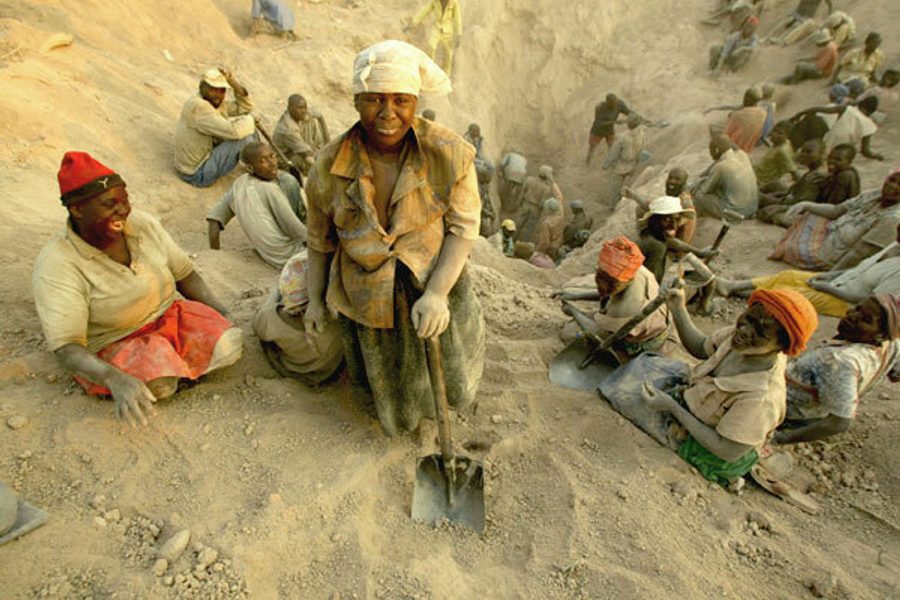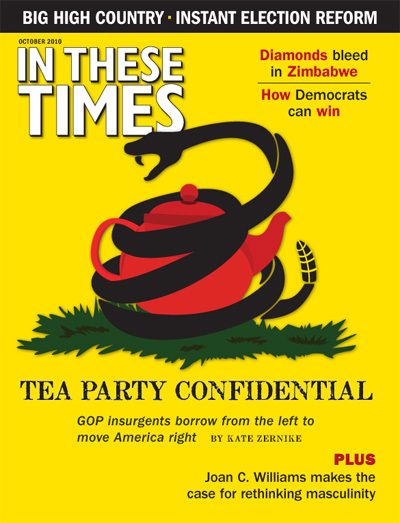Blood Stains Zimbabwe Diamonds
After a promising discovery, endemic corruption causes hope to fade.
Sam Gregory

MUTARE, ZIMBABWE – In 2006, Zimbabwe was on its knees. The country had been through a disastrous election the year before, marred by violence and fraud. Healthcare, almost nonexistent to start with, was receding, starvation was prevalent in rural areas and the effects of hyperinflation were taking a heavy toll on the economy. At the same time, international observers called for President Robert Mugabe to step down while his party, the Zimbabwe African National Union-Patriotic Front (ZANU PF), encouraged acts of violence against those who had not voted for him. It seemed Zimbabwe could stand no more.
But in June of that year, word began to spread of a diamond discovery in Manicaland, near the eastern border. The diamonds were small news at first, but in the next few months it became apparent that Zimbabwe had been thrown a lifeline. The long-suffering population realized the potential for economic growth and comparative stability, and after such a long and desperate time, it must have been a relief. The more cynical Zimbabweans, however, saw an impending conflict: great wealth up for grabs in a politically volatile climate. While the public celebrated, the corrupt minds behind Mugabe’s ZANU PF began to envisage the diamond wealth in their own pockets.
Fast forward to the present day. A few pockets have been filled, but the situation remains bleak for the average Zimbabwean.
The slaves of Mugodhi Hasha
Mutare, a town on Zimbabwe’s eastern border with Mozambique, lies nestled in the highlands of Manicaland province. To the west are the endless plains of flat, dry, typically African country, and to the east are the highlands. From Mutare, all you can see are the bush-clad mountains that surround the town and give it a dramatic, slightly intimidating backdrop.
Despite the natural beauty of the place, it is obvious to outsiders that something’s amiss. There’s a tension in the air here, stemming from the fact that Mutare’s residents are frightened of what happens on the other side of the mountains. Many of them have witnessed or been directly affected by the atrocities committed at the Marange and Chiadzwa mines that lie 20 miles to the west. The locals have a name for the mines that sums up their fear: Pits of Fury–Mugodhi Hasha in their native Shona.
Trymore Kambudzi (his name has been changed to protect his safety) lives on the streets of Mutare. He’s 16 years old and he sells Zimbabwean flags, along with other souvenirs, to the few tourists who pass through the border town. On a street corner near the center of town, he tells me that in 2007, he and his family were forcibly evicted from their home in Marange as part of the militarization of the nearby mines. For this he counts himself lucky – many were not so fortunate. “A lot of friends and people I knew were forced to work in the mines without pay,” Kambudzi says.
These latter-day slaves have been subjected to violence that has attracted the notice of the world’s human rights community. But Kambudzi has yet to see many of the people he left behind.
“There are stories about people you knew,” he says. “I hear rumors about something bad happening to friends, but how do I know? My family was just lucky we got moved away.” The government and the mining companies promised to cover the costs of the home they took from his family, but so far they haven’t seen a cent, and don’t expect to.
Everyone who is willing to talk about diamonds in Mutare (many aren’t) has a story of violence or death. A taxi driver, who agreed to take me as close to the mines as he could, told me about the initial appearance of the military at the mines and how the situation escalated. During the early stages of the diamond rush in late 2006, more than 20,000 Zimbabweans flocked to Manicaland province from all corners of the country.
Educated professionals who couldn’t find jobs in Bulawayo or Harare, the capital, or who weren’t being paid for the jobs they had, were moving to Manicaland to make their fortunes – or just enough to survive – in the diamond fields. At first, he says, there were only miners and a small number of officials. But as the army moved in, the mood changed. Miners were beaten and sometimes killed. The soldiers formed syndicates to smuggle diamonds to the Mozambique border and the South African border at Beitbridge. Those who were not in the syndicates or who angered the soldiers were often killed. From his home near Bazeley Bridge, the taxi driver says he sometimes heard machine gun fire in the distance.
Along the way to the mines, the taxi driver pulled the car to the side. The first roadblock was just over the horizon, and he didn’t want to drive too close. If soldiers saw us turn around in front of the roadblock, they might follow. “The fact that you’re white will make the soldiers suspicious of us,” he says.
In its scramble to gain control of the diamond fields in 2008, the government killed and wounded hundreds of Zimbabweans, perhaps thousands. Soldiers used dogs to track the miners who hid in the surrounding bush. Most were killed by small arms fire or beatings, but there were reports of helicopters being used to fire upon miners as they tried to find cover in the pits. Nongovernmental organizations such as Global Witness and Human Rights Watch have compiled reports of murder, torture and rape at the mines, particularly Chiadzwa. They claim the abuses are still occurring at the mines and accuse the Zimbabwean government of covering up the violence. People I spoke with in Manicaland confirmed that forced labor and violence are still occurring on a large scale.
Back in Harare, Munya Radzi, an elder from a small village near Chimanimani, 40 miles south of Mutare, spoke of the early days of what he calls “the rush.” “You couldn’t help but get excited,” Radzi says. In 2007, a young man who had been working at a farm nearby approached him. “The boy handed me a stone the size of a strawberry. It was like a normal stone but you could see into it slightly.”
A period of comparative prosperity in the community was brutally cut short when the police and army moved into the town and began to force people into trafficking diamonds between the mines and Vila De Manica, Mozambique. The soldiers would take most or all of the profits from the miners. “This is why I moved to the city,” he says.
‘When the president is greedy, the people are poor’
Human rights abuses, slavery and murder are manifestations of Zimbabwe’s rampant corruption. In Transparency International’s 2009 Corruptions Perceptions Index, Zimbabwe ranked as one of the most corrupt: 146th out of 180 nations. For a country with so little, Zimbabwe stands to lose a lot.
The diamonds themselves are generally low quality, suitable for industrial sale only. Five to 10 percent are gem quality; these fetch a far higher price. But it is the sheer quantity of diamonds in the Marange area that has caused such a stir in the international mining industry. Most estimates value the diamonds at between $1.5 and $2 billion per year for the next 10 years, at least. Diamonds already stockpiled by the government have been estimated at $1.7 billion. With this sort of money up for grabs, corruption is inevitable.
African Consolidated Resources, a company registered in London, owned the land where the majority of the diamonds lie and was in the process of setting up mining operations when the government invaded and occupied the property. Soon after it had appropriated the land, the Mugabe government set up two companies to mine and sell the diamonds.
These companies, joint ventures between South African investors and the Zimbabwean government, are named Mbada Diamonds and Canadile Miners. The board of directors at both Mbada and Canadile consist of ZANU PF supporters, family members of politicians and shady figures in the diamond trading industry. It recently came to light that Grace Mugabe, President Mugabe’s wife, is a director at Mbada Diamonds, and Minister of Mines Obert Mpofu, a ZANU PF member of parliament, is widely believed to be a director of Canadile.
Mpofu is apparently benefiting from a source of income over and above his salary as a minister. Earlier this year, he purchased a considerable amount of property in Bulawayo, including a race course and a casino.
So far, for all the hundreds of millions of dollars worth of diamonds sold illegally by the government and its agencies, only $800,000 has been deposited into government coffers. The rest has disappeared into anonymous pockets. Investigations conducted by the Zimbabwe Independent, a weekly published in Harare, have revealed that profits from illegal diamond sales have been deposited into private Harare bank accounts in ABC (BancABC based in Gabarone, Botswana) and CBZ (Commercial Bank of Zimbabwe, based in Harare) via money transfers from a New York branch of Standard Chartered, a London-based bank.
Rudzi, the elderly man from the Chimanimani area, expressed his sense of betrayal when asked about the accusations of corruption being directed at the government. “When the president is greedy, the people are poor,” he says.
Enter the Kimberley Process
In July, the Kimberley Process (KP), a civic society concerned with the ethical mining and selling of diamonds, met in St. Petersburg, Russia, to discuss the issue of Zimbabwe’s diamonds. A June meeting in Tel Aviv, Israel, upheld a previously issued sales ban on all Zimbabwean-mined diamonds on the grounds of human rights abuses and a lack of transparency.
Presented with overwhelming evidence of abuse and corruption, the KP was faced with a dilemma. Weeks before, Mugabe had threatened to sell the diamonds with or without KP certification. If the ban was upheld, Mugabe would sell the stones to China or Iran for a lower price, Zimbabwe would be expelled from the KP, and there would be fewer controls on mining and sales.
At its St. Petersburg meeting, the KP chose to lift the ban. By doing so, it retained access to the mines and a measure of control over legitimate sales.
Accusations of corruption within the KP have also surfaced recently. The KP’s first choice of inspector for Zimbabwe’s diamond industry was rejected by Mugabe himself, raising questions of why current KP inspector Abbey Chicane, a South African, was deemed suitable. Chicane has consistently belittled reports of human rights abuses and illegal mining. He is widely known to have been responsible for the June 3 arrest in Mutare of Farai Maguwu, a Zimbabwean human rights activist who was subsequently jailed for allegedly providing false information to the KP.
Most Zimbabweans I’ve spoken to agree with KP’s decision to lift the ban. Although they’ve resigned themselves to a large amount of government corruption, the perception is that they’ll get more from legal sales than illegal.
Where to from here?
Many think the diamonds in Zimbabwe’s soil could be the source of its financial recovery. Certainly, if administered correctly and without excessive corruption, the mines could boost the fortunes of Zimbabwe’s failing economy. In terms of domestic politics, the diamond issue has done serious damage to relations within the current coalition government. Members of the MDC, Movement for Democratic Change, particularly Minister of Finance Tendai Biti and Prime Minister Morgan Tsvangarai, have expressed revulsion at the fact that, while people are starving, ZANU PF politicians and their associates are becoming rich from stolen national resources. They’ve also indicated that the diamonds may be used to fuel violence during the elections scheduled for next year.
While on its knees, Zimbabwe was handed an opportunity by Mother Nature herself. At this point, it appears the opportunity has been squandered.





